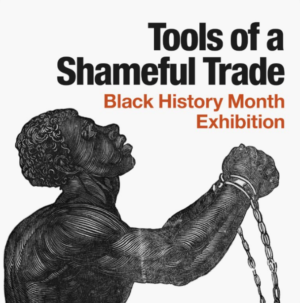Tools of a Shameful Trade
Black History Month Exhibition
Through February, 2019
 Marking Black History Month, the Wilton Historical Society presents Tools of a Shameful Trade, a small exhibition of slavery artifacts. Though many of the objects which can be seen are from the south, slavery in Connecticut dates back as far as the mid-1600s. The objects on display include a neck collar, shackles, a plantation whip, and an 1835 broadside advertising a runaway slave. Also shown is a 1808-1824 ledger kept by Samuel Wakeman of Fairfield, which includes references to eight individuals with African ancestry – Jeffrey Freeman, Frederick, Primus Burr, Titus Freemen, John, Ned Freeman, Hiram and Primas Jenning. There were a surprising number of families who owned slaves in Wilton, including the well-known Lambert family, whose ancestral home can be seen at 150 Danbury Road at Lambert Corner. A 1757 letter from the Wilton Historical Society’s permanent collection confirms the sale of a slave named Jack to David Lambert; it is also exhibited. Tools of a Shameful Trade will be on display through the end of February, 2019.
Marking Black History Month, the Wilton Historical Society presents Tools of a Shameful Trade, a small exhibition of slavery artifacts. Though many of the objects which can be seen are from the south, slavery in Connecticut dates back as far as the mid-1600s. The objects on display include a neck collar, shackles, a plantation whip, and an 1835 broadside advertising a runaway slave. Also shown is a 1808-1824 ledger kept by Samuel Wakeman of Fairfield, which includes references to eight individuals with African ancestry – Jeffrey Freeman, Frederick, Primus Burr, Titus Freemen, John, Ned Freeman, Hiram and Primas Jenning. There were a surprising number of families who owned slaves in Wilton, including the well-known Lambert family, whose ancestral home can be seen at 150 Danbury Road at Lambert Corner. A 1757 letter from the Wilton Historical Society’s permanent collection confirms the sale of a slave named Jack to David Lambert; it is also exhibited. Tools of a Shameful Trade will be on display through the end of February, 2019.
Research has revealed that a black slave named Haggar, born 1770, and owned by Wilton’s Samuel Belden II, was married to a Native American slave named Bill Tonquin. Tonquin was owned by another branch of the Belden family in Wilton. Haggar and Bill Tonquin had three children, Prince, Nancy and Black Jack, and lived in the Belden Store at the corner of Ridgefield Road and “Danbury Pike” a crossways that is at the heart of Wilton’s town center. Haggar Tonquin is documented as being the last slave in Wilton. Her children were slaves, but were born with the promise of freedom, as they would have been freed at age 21 by the Connecticut law passed in 1783.
Wilton had a stop on the Underground Railroad, at the home of the abolitionist William Wakeman on Seeley Road.
This exhibition would not be possible without generous exhibition loans by John and Samantha Reznikoff.